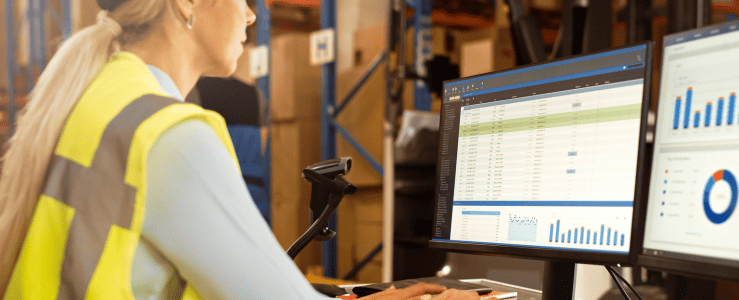Blog

3 Reasons to Upgrade Your SAP B2B eCommerce Manufacturing Strategy
The impetus? Growth.
The means? Faster digital transformation.
The how? The right eCommerce strategy, platform ….and eCommerce and SAP ERP integration.
Key Takeaways:
- An eCommerce site is essential for B2B companies operating in today’s business environment
- A B2B eCommerce strategy should enable the best customer/dealer/distributor experience, meet business objectives, and get up and running fast
- Your direct customers and dealers/distributors have the same customer experience demands as consumers
- Everyone wants a site that gives them a time-saving purchasing journey; seamless self-service; and accuracy when it comes to pricing, timing, and product availability
- Your business objectives must be clearly defined, whether that’s expanding your current market or expanding into new ones
- One key to providing these experiences is the data siloed in your SAP ERP system.
- Integration of your SAP ERP and self-service eCommerce platform is essential to deliver pricing info, product configuration options, and shipping information accurately to your platform users and drive adoption.
There’s no question that manufacturers need an eCommerce site to offer a self-service customer experience, meet business objectives and financial targets, and achieve the digital transformation required to compete in today’s marketplace. This defines the three essential pillars of your eCommerce strategy.
It’s not just about eCommerce, though. Digital transformation – including SAP ERP integration – marks a big shift in the way manufacturers have always done business. All three of these pillars go together to create a successful modern enterprise with state-of-the-art technology to unite every part of the business and provide the real-time data and analysis required to outshine the competition.
As a manufacturer, you know a haphazard approach to developing a new product is a non-starter. The same applies to your digital transformation plan, which will not only support your eCommerce site but supercharge your entire business. Here’s how to define these variables and achieve the synergy that spells business success.
Pillar 1: Customer needs
Calling this “customer needs” is a bit of a misnomer – it is actually all about what your customers, dealers, and distributors are demanding. Today’s B2B buyer expects the same seamless experience they get from consumer sites, and now is the perfect time to get ahead of your competitors. Unfortunately, the gulf between what manufacturing customers want and what they get is quite wide. According to McKinsey, 90% of industrial B2B buyers are purchasing remotely, only 18% of manufacturers say their online offerings are customer-centric.
What is driving the adoption of self-service eCommerce? When done right, it leads to a better, more seamless, and less time-consuming purchase that saves everyone the hassle of an in-person visit or phone call. But manufacturing customers, distributors, and dealers will only adopt your self-service eCommerce platform if it delivers accurate information and leads to a hassle-free customer journey. If they place an order online only to find out later that you didn’t have the parts in stock to deliver it on time, that’s going to be a deal-breaker.
That’s why providing accurate, real-time information to that portal is essential. Most of these buyers, whether they’re direct buyers or dealers, don’t want face-to-face selling. In fact, 60% of your customers feel buying online can provide the same experience as traditional sales methods, and 62% want to be able to reorder online.
There is a huge opportunity here. That same McKinsey study found that only 13% of industrial OEMs offer the digital pathway their customers want, and only 10% have a self-service portal. Manufacturers who can offer a seamless self-service experience have a huge advantage over the competition when it comes to winning repeat business and freeing up their sales and customer service people to focus on more growth-oriented tasks.
So what does it take to give your customers – 59% of whom are digitally savvy millennials – what they want and keep them coming back for more? One word: data.
Through the data you already have and what you will collect via an online sales platform, you’ll be able to provide the right online customer experience to turn your eCommerce site into a growth engine. That experience must include:
- An eCommerce portal that accurately reflects their specific account rules, pricing, product availability, and time to delivery
- Comprehensive, intuitive product search capabilities
- Account-specific product recommendations, upsells, and cross-sells
- Inventory and availability visibility
- Easy access to order and invoice history
- 24/7 customer service
- Quick reorder capabilities via a self-service portal
- Access anytime and anywhere on any device
This information is not going to come from your eCommerce platform alone. A lot of the data you already have is siloed in your SAP ERP. Integration of your SAP ERP with the eCommerce system is what ensures pricing accuracy, shipping, and delivery information in the self-service portal.
Pillar 2: Define your eCommerce Goals
When setting the goals for your self-service B2B eCommerce site, saying you want more business isn’t enough. You must pinpoint everything you want to achieve with your platform. There’s a lot to gain from digital transformation and a robust, customer-centric eCommerce site when you clearly define how your new capabilities will drive company growth. Among these goals should be:
- Reaching new customers: Self-service eCommerce is a great way to engage customers who have been difficult to reach, cost too much to serve, or don’t offer enough value for your salespeople to spend much time on them.
- Reducing the costs of serving customers: Much of the buying journey can be more cost-effectively delivered digitally, including discovery, evaluation, purchasing, and support. Sales or customer support teams can then add an additional personalized touchpoint for larger, more valuable customers while less valuable customers can find everything they need in the self-service portal.
- Capturing market share: By creating a differentiated, personalized customer experience, more customers will come back to you and tell contacts at other companies how good that experience was. This allows manufacturers to employ the Flywheel model made famous by Jeff Bezos and Amazon.
- Automating manual tasks: A good self-service portal automates processes from orders and reorders to data integration and order creation. That frees up employee time to do things that will contribute more to reaching your strategic goals.
- Improving sales team productivity: When customers can reorder online at their convenience and new prospects can find basic inventory, pricing, and order information on your website, all your sales team has to do is nurture their leads and guide new business into your pipeline.
- Enabling market testing: One of the things eCommerce is great for is testing. With a digital portal, you gain access to A/B testing of different product recommendations and layouts as well as pre-sales testing to assess interest for new products and other ideas.
A key consideration of your eCommerce goals is to determine which parts of the buyers’ journey should be targeted. For example, you can build your strategy around costly parts of the journey that have a low value-add and then focus on elements that will have the largest influence on creating the best experience.
Pillar 3: Embracing digital transformation
The main driver for B2B digital transformation may be elevated customer, distributor, and dealer expectations, which are compounded by competitive pressure, but it creates efficiencies in all areas of your organization. Time is of the essence if you want to stay competitive, give your customers what they want, and achieve your goals. Accurate, real-time data will give you a better understanding of your customers and your supply chain. This knowledge gives you the flexibility, scalability, and analytics you need to power your business today and tomorrow.
Where is your data? It’s sitting in SAP and often never makes its way to the front end in your CRM or eCommerce platform. To get what you need, you have to unite these systems and embrace digital transformation.
Delivering a good, real-time eCommerce experience means your customer and product data must be updated in real-time between SAP and your frontend. You eliminate customer disappointment because you can guarantee inventory availability, and when a shopping cart is submitted, an accurate, SAP-validated order is created automatically.
Integration also gives your customers visibility into their order history across all channels and accurate real-time pricing, including customer-specific pricing, discounts, and tax obligations. Your integrated system can validate orders and create them in SAP in real-time. Your custom business logic from SAP is automatically applied, which means orders are always correct.
By taking a systemized approach to planning and making the correct vendor choices, you can grab a chunk of the 17.5% CAGR predicted for B2B eCommerce just by giving your customers what they want.
When you’re ready to take the next steps toward B2B eCommerce and digital transformation, the next step is building the business case to get the rest of your stakeholders on board. For that, review the on-demand webinar Building the Business Case for Salesforce B2B eCommerce where we discuss best practices and key takeaways from SAP Manufacturers who have successfully sold it to their stakeholders.


